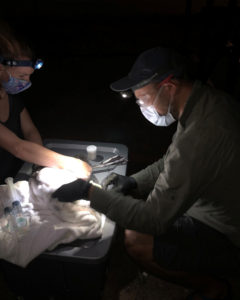Consulting Wildlife Health Program Director

Tristan evaluates a common loon in the field as part of BRI’s loon relocation program.
Tristan Burgess, B.V.Sc., PhD
Consulting Wildlife Health Program Director
tburgess@centerforwildlifestudies.org
207-3705518
Tristan is a wildlife veterinarian and epidemiologist. He co-founded the Center for Wildlife Studies in 2019, where he serves as Vice President and Wildlife Veterinarian. Through the Center for Wildlife Studies, Tristan provides field veterinary services and consults on wildlife health management for state and federal governments as well as conservation NGOs and some of the finest zoos and aquaria in the US.
Tristan joined BRI as the Consulting Wildlife Health Program Director in 2020. At BRI, Tristan works collaboratively with other Program Directors and field staff to develop, implement, and assist with wildlife studies requiring veterinary expertise and services. As our consulting veterinarian, Tristan assists with the development of BRI’s Institutional Animal Care and Use Committee (IACUC) applications
Education & Certifications
- B.V.Sc. Veterinary Science, Massey University
- Ph.D. Wildlife Epidemiology, University of California, Davis
Research Interests and Projects
Research Interests
- How health and disease can impact, or be used to measure, conservation outcomes
- Drivers of spillover risk in emerging infectious disease
- The intersection of behavioral/foraging ecology and animal health
Projects
- Emerging pandemic threats: Tristan serves as the wildlife field team lead for the USAID-funded STOP Spillover project, which is being implemented by a large consortium of partners based at Tufts University. STOP Spillover is focused on strengthening national capacity in specific countries at high risk of zoonotic spillover of potential novel pandemic pathogens to 1) understand the factors that contribute to the risk of spillover of pathogens from wildlife to humans; 2) develop, assess, and implement early risk-reduction interventions that will reduce the spillover and spread of these threats; and 3) recognize and respond rapidly to zoonotic spillover events.
- Marine mammal health and stranding: Tristan runs a federally funded necropsy capacity enhancement project based here in Maine. This project involves doing field necropsies on large whales, dolphins and seals, as well as providing training, diagnostic assistance and sampling supplies to the two principal marine mammal stranding response organizations in Maine. This helps these organizations do the smelly and difficult work of learning how and why marine mammals die or get sick and strand on the coast of Maine, so that we can use that knowledge to manage marine mammals better.
- Veterinary Field Services: Tristan provides wildlife field veterinary services such as capture and field health assessment including assisting in the BRI Loon Translocation Project in 2020.
- Wildlife Epidemiology Consulting: Tristan serves as a consultant to non-profit and public sectors, providing wildlife epidemiology research and consulting services including observational studies, surveillance and disease risk assessment.
- Other research interests: Tristan has a growing project on lead toxicity in northeastern wildlife, currently focused on birds, but expanding to include some carnivores as well. The hope is to develop better diagnostic and analytical tools to understand the variation in risk of lead intoxication for different wildlife species across the landscape and study the interaction of lead intoxication and other health outcomes.
Selected Publications
- Miller MA, Moriarty ME, Henkel L, Tinker MT, Burgess TL, Batac FI, Dodd E, Young C, Harris MD, Johnson CK. 2020. Predators, Disease, and Environmental Change in the Nearshore Ecosystem: Mortality in southern sea otters (Enhydra lutris nereis) from 1998-2012. In Press: Frontiers in Marine Science
- Burgess T.L., M.T. Tinker, M.A. Miller, J.L. Bodkin, M.J. Murray, L.M. Nichol, J.A. Saarinen, S. Larson, J.A. Tomoleoni, P.A. Conrad, & C.K. Johnson. 2020. Spatial epidemiological patterns suggest mechanisms of land-sea transmission for Sarcocystis neurona in a coastal marine mammal Nature Scientific Reports 10:3683
- Burgess T.L., M.T. Tinker, M. Miller, J. Bodkin, M. Murray, L. Nichol, S. Larson, J.A. Saarinen, P.A. Conrad, & C.K. Johnson. 2018. Defining the risk landscape in the context of pathogen pollution: Toxoplasma gondii in sea otters along the Pacific Rim. Royal Society Open Science (2018 5 171178).
- Plourde B.T., T.L. Burgess, W.A. Eskew, T. Roth, N. Stephenson, & J. Foley. 2017. Are disease reservoirs special? Characteristics of hosts responsible for pathogen spillover. PLoS One 12(7):e0180716.
- Burgess T.L., C.K. Johnson, A. Burdin, V.A. Gill, A.M. Doroff, P. Tuomi, W.A. Smith, & T. Goldstein. 2017. Brucella infection in Asian Sea Otters (Enhydra lutris lutris) on Bering Island, Russia. Journal of Wildlife Diseases 53:864–868.
- Burgess T.L., C.W. Witte, & B.A. Rideout. 2017. Early-life exposures and Johne’s disease risk in zoo ruminants. Journal of Veterinarian Diagnostic Investigation 30:78–85.
- Miller M.A., T. L. Burgess, E. Dodd, K. Nielsen, J. Rhyan, S. Jang, B. Byrne, F. Gulland, M.J. Murray, P.A. Conrad, & W.A. Smith. 2017. Isolation and characterization of a novel marine Brucella from a southern sea otter (Enhydra lutris nereis) with granulomatous arthritis, myelitis and hepatitis. Journal of Wildlife Diseases 53:215–227.


